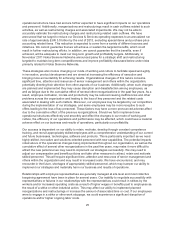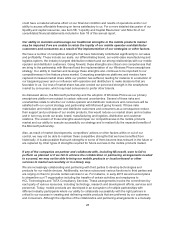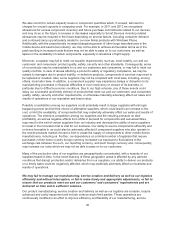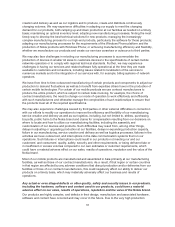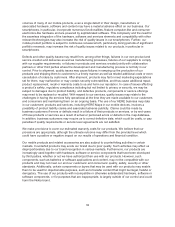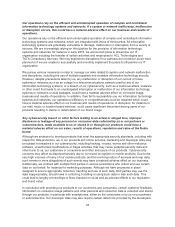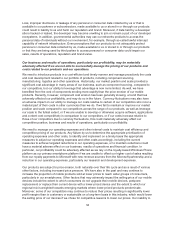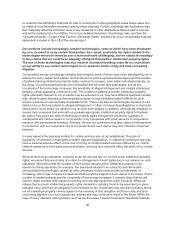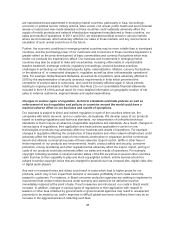Nokia 2012 Annual Report Download - page 36
Download and view the complete annual report
Please find page 36 of the 2012 Nokia annual report below. You can navigate through the pages in the report by either clicking on the pages listed below, or by using the keyword search tool below to find specific information within the annual report.lower our costs at the same rate or faster than the price erosion of our mobile products could have a
material adverse effect on our business and results of operations, particularly our profitability.
We have operations in a number of countries and, as a result, face complex tax issues and
could be obligated to pay additional taxes in various jurisdictions and our actual or anticipated
performance, among other factors, could result in allowances related to deferred tax assets.
We operate our business in a number of countries which involve different tax regimes and the
application of rules related to taxation. Applicable taxes, VAT and social taxes for which we make
provisions could increase significantly as a result of changes in applicable tax laws in the countries
where we operate, the interpretation of those laws by local tax authorities or tax audits performed by
local tax authorities. The impact of these factors is dependent on the types of revenue and mix of profit
we generate in various countries; for instance, profits from sales of devices or services may have a
different tax treatment.
Nokia is subject to income taxes in Finland and in numerous other jurisdictions. Our business and
investments globally and especially in emerging market countries are subject to uncertainties, including
unfavorable or unpredictable tax law changes (even possibly with retroactive effect), taxation treatment
and regulatory proceedings including tax audits. For instance, during early 2013 Nokia became subject
to a tax investigation in India, apparently focusing on Indian tax consequences of payments made
within Nokia for the supply of operating software from its parent company in Finland. Such proceedings
can be lengthy, involve actions that can hinder local operations and the outcome of such proceedings
is difficult to predict. Negative developments or outcome in such proceedings could have adverse
effects to our cash flows, income statements and to our financial position.
Deferred tax assets recognized on tax losses, unused tax credits and tax deductible temporary
differences are dependent on our ability to offset such items against future taxable income within the
relevant tax jurisdiction. Deferred tax assets recognized on tax losses, unused tax credits and tax
deductible temporary differences are based on our assumptions for future taxable earnings and these
may not occur as planned, which may cause the deferred tax asset to be reduced. There can be no
assurances that an unexpected reduction in deferred tax assets will not occur. Any such reduction
could have an adverse effect on us. Additionally, our earnings have been and may continue to be in
the future unfavorably impacted by Nokia Siemens Networks and Devices & Services taxes as no tax
benefits are recognized for certain Nokia Siemens Networks and Devices & Services deferred tax
items. There may also be unforeseen tax expenses which may have an unfavorable impact on us. As a
result and given the inherent unpredictable nature of taxation, there can be no assurance that the
estimated long-term tax rate of Nokia will remain at current levels or that cash flows regarding taxes
will be stable.
Our net sales, costs and results of operations, as well as the US dollar value of our dividends
and market price of our ADSs, are affected by exchange rate fluctuations, particularly between
the euro, which is our reporting currency, and the US dollar, the Japanese yen and the Chinese
yuan, as well as certain other currencies.
We operate globally and are therefore exposed to foreign exchange risks in the form of both transaction
risks and translation risks. Our policy is to monitor and hedge exchange rate exposure, and we manage
our operations to mitigate, but not to eliminate, the impacts of exchange rate fluctuations. There can be
no assurance, however, that our hedging activities will be successful in mitigating the impact of exchange
rate fluctuations. In addition, significant volatility in the exchange rates may increase our hedging costs,
as well as limit our ability to hedge our exchange rate exposure in particular against unfavorable
movements in the exchange rates of certain emerging market currencies and could have an adverse
affect on our results of operations, particularly our profitability. Further, exchange rate fluctuations may
have an adverse affect on our net sales, costs and results of operations, as well as our competitive
position. Exchange rate fluctuations may also make our pricing more difficult as our products may be
35


